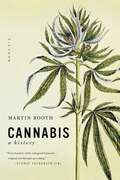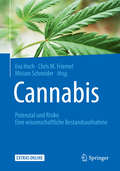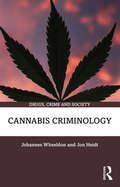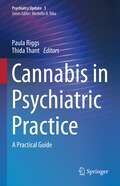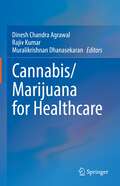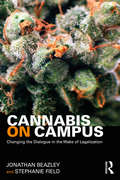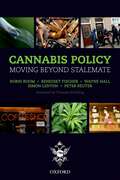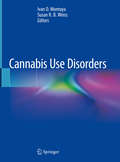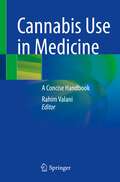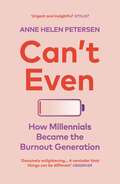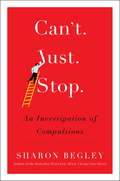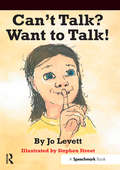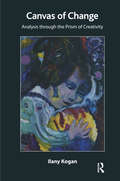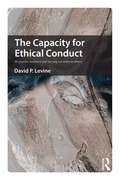- Table View
- List View
Cannabinoids and the Brain
by Attila KöfalviEndocannabinoids have tremendous therapeutic potential. This book introduces readers to our current understanding of the neurobiology of endocannabinoids and related systems, detailing their pathophysiological role and therapeutic potential. Authors, experienced clinical investigators, present and analyze results of recent clinical trials as well as the development of new therapeutic strategies and medicines.
Cannabinoids as Therapeutics (Milestones in Drug Therapy)
by Raphael MechoulamOnly a few years ago the endocannabinoid system was unknown. Today we are aware that endocannabinoids are involved in many of the functions of the mammalian body - in neuroprotection, appetite and suckling, pain, reproduction, anxiety, memory, bone formation etc. This volume presents an up-to-date picture of some of the major fields of endocannabinoid research. It summarizes the actions of the endocannabinoids on various physiological systems and opens new therapeutic windows to a large number of diseases.The first chapter, on the use of Cannabis in India, can be viewed as an expression of thanks to the herbal practitioners, who for centuries passed on the medical traditions associated with the drug. The chapter on chemistry is a short summary of active plant, synthetic and endogenous cannabinoids being investigated today, many of which are mentioned later in the book. Cannabidiol is an unusual cannabinoid - it does not bind to the known receptors and yet exerts a variety of effects. Hence a chapter is devoted to it. Further chapters deal with the endocannabinoid system and the endocannabinoids in a variety of conditions and physiological systems. The concluding chapter describes the research done on Sativex®, a standardized plant extract, shortly to be introduced in Canada as a drug for multiple sclerosis.The intended audience is drug researchers (medicinal chemists, pharmacologists, clinicians), neuroscientists, physiologists, and clinicians interested in the effect of the endocannabinoid system in various physiological systems.
Cannabis: A History (PDF)
by Martin BoothTo some it's the classic gateway drug, to others it is a harmless way to relax, or provide relief from pain. Some fear it is dangerous and addictive, while others feel it should be decriminalized. Whatever the viewpoint, cannabis incites debate at every level, and the effect it has on every corner of the globe is undeniable. In this comprehensive study, Martin Booth crafts a tale of medical advance and religious enlightenment; of political subterfuge and law enforcement; of cunning smugglers, street pushers, gang warfare, writers, artists, and musicians. And above all, Booth chronicles the fascinating process through which cannabis became outlawed throughout the Western world, and the effect such legislation has had on the global economy.
Cannabis: Eine wissenschaftliche Bestandsaufnahme
by Eva Hoch Chris Maria Friemel Miriam SchneiderDieses Buch fasst den aktuellen Forschungsstand zum Thema Cannabis zusammen. Hierfür wurden alle bedeutsamen, in den letzten 10 Jahren in deutscher und englischer Sprache publizierten Forschungsarbeiten systematisch recherchiert und ausgewertet. Dargestellt werden: - psychische, organische und soziale Risiken des Konsums pflanzlicher und synthetischer Cannabisprodukte zu Rauschzwecken, - Wirksamkeit, Verträglichkeit und Sicherheit von Cannabisarznei bei organischen und psychischen Erkrankungen, - Motive und Erwartungen eines nichtärztlich verordneten Gebrauchs von Cannabis im Sinne einer Selbstmedikation. Die Expertise liefert einen umfassenden Überblick über die aktuelle Literatur. Sie bewertet das therapeutische Potenzial und die Risiken von Cannabis entsprechend internationaler methodischer Vorgaben der evidenzbasierten Medizin. Die Expertise dient somit als solides Nachschlagewerk. Ihr Auftraggeber war das Bundesministerium für Gesundheit.
Cannabis and Young People: Reviewing the Evidence (Child and Adolescent Mental Health)
by Richard JenkinsThis book aims to shed light on the current debates of cannabis by reviewing all the available evidence on a range of issues relating to the use of cannabis among children and adolescents and summarizing the main conclusions in clear, jargon-free language.
Cannabis Criminology (Drugs, Crime and Society)
by Johannes Wheeldon Jon HeidtCannabis Criminology explores the prohibition, decriminalization, and liberalization of cannabis policy through the lens of criminological and sociological theory, essential concepts, and cannabis research. It does so by focusing on five thematic areas: law, society, and social control; police and policing; race, ethnicity, and criminalization; the economics of cannabis use; and cannabis use and crime. It is the first book on cannabis since President Joe Biden signed an executive order in 2022 to pardon citizens and lawful permanent residents convicted of simple cannabis possession under federal law and DC statute. Cannabis is now legal in some form in 37 US states. To understand the reform of cannabis policy and the challenges to come, we first need to understand the connections between cannabis and criminology. The book links key areas in past and contemporary cannabis research to criminological and sociological theories, including key concepts, emergent concerns, and new directions. Based on an up-to-date review of this growing area of research, the book outlines a research program based on five essential thematic areas. Introducing cannabis as a critical case study in moral-legal re-negotiation, it outlines how cannabis prohibition has influenced cannabis around the world. Five discrete chapters focus on thematic areas, criminological and sociological theories, define essential concepts, and provide research focused on law, society, and social control (Chapter 2), police and policing cannabis (Chapter 3), race, ethnicity, and criminalization (Chapter 4), the economics of cannabis (Chapter 5), and cannabis and crime (Chapter 6). The book concludes by presenting new ways to engage prohibitionist thinking, by challenging myths, embracing social media, and developing a duty of care to guide future cannabis researchers and explicitly involve people who use cannabis. Cannabis Criminology will be of interest to a variety of readers, including students and scholars from a range of backgrounds studying drug use, drug policy, cannabis legalization, and other drug-related issues. It will also appeal to policymakers who want to know more about cannabis legalization and drug prohibition, those working in the criminal justice system, and social work professionals. Due to its accessible style, people involved in the cannabis industry, as well as cannabis users may also find the book interesting.
Cannabis Criminology (Drugs, Crime and Society)
by Johannes Wheeldon Jon HeidtCannabis Criminology explores the prohibition, decriminalization, and liberalization of cannabis policy through the lens of criminological and sociological theory, essential concepts, and cannabis research. It does so by focusing on five thematic areas: law, society, and social control; police and policing; race, ethnicity, and criminalization; the economics of cannabis use; and cannabis use and crime. It is the first book on cannabis since President Joe Biden signed an executive order in 2022 to pardon citizens and lawful permanent residents convicted of simple cannabis possession under federal law and DC statute. Cannabis is now legal in some form in 37 US states. To understand the reform of cannabis policy and the challenges to come, we first need to understand the connections between cannabis and criminology. The book links key areas in past and contemporary cannabis research to criminological and sociological theories, including key concepts, emergent concerns, and new directions. Based on an up-to-date review of this growing area of research, the book outlines a research program based on five essential thematic areas. Introducing cannabis as a critical case study in moral-legal re-negotiation, it outlines how cannabis prohibition has influenced cannabis around the world. Five discrete chapters focus on thematic areas, criminological and sociological theories, define essential concepts, and provide research focused on law, society, and social control (Chapter 2), police and policing cannabis (Chapter 3), race, ethnicity, and criminalization (Chapter 4), the economics of cannabis (Chapter 5), and cannabis and crime (Chapter 6). The book concludes by presenting new ways to engage prohibitionist thinking, by challenging myths, embracing social media, and developing a duty of care to guide future cannabis researchers and explicitly involve people who use cannabis. Cannabis Criminology will be of interest to a variety of readers, including students and scholars from a range of backgrounds studying drug use, drug policy, cannabis legalization, and other drug-related issues. It will also appeal to policymakers who want to know more about cannabis legalization and drug prohibition, those working in the criminal justice system, and social work professionals. Due to its accessible style, people involved in the cannabis industry, as well as cannabis users may also find the book interesting.
Cannabis in Psychiatric Practice: A Practical Guide (Psychiatry Update #3)
by Paula Riggs Thida ThantThis book educates and familiarizes psychiatrists with the impact of cannabis beyond the scope of addiction and ways to effectively discuss the existing literature and knowledge with patients. Cannabis in Psychiatric Practice is organized by clinical setting to help tailor the literature to psychiatrists and other mental health clinicians working in all areas, whether traditional outpatient clinics, emergency departments, inpatient psychiatry or medical units. It helps readers, regardless of their training background, learn about the impact of cannabis on a variety of disorders in a manner adjusted to the unique needs and challenges of their particular treatment settings and patient populations. The book also includes clinical cases and practical tips integrating the current evidence, treatment approaches, and psychoeducation needed to effectively practice in the era of modern-day psychiatry and cannabis legalization. Chapters are written in a clear, easy-to-read style, allowing readers to reference specific portions of the book as needed, increasing its utility for the general psychiatrist and mental health clinician. With the increasing prevalence and availability of cannabis and CBD products, this book is an invaluable reference for psychiatrists who wish to explore the impact of cannabis in their clinical practice.
Cannabis/Marijuana for Healthcare
by Dinesh Chandra Agrawal Rajiv Kumar Muralikrishnan DhanasekaranThe book contains review articles providing a comprehensive overview of cannabis/marijuana’s diverse healing aspects in human healthcare (medicinal, nutraceutical, skincare, etc.). The research articles include the role of cannabis in cancer treatment, drug discovery, cosmeceutical potential, prophylactic and therapeutic use for treating neuropathic pain and migraine, pharmacokinetics, safety profile, and issues related to the consumption of cannabis/marijuana. Another salient feature of the book is a complete mapping and region- and sector-wise critical analysis of cannabis/marijuana patents on healthcare and future directions for the benefit of researchers and businesses/entrepreneurs interested in the rapidly advancing area of cannabis. The text describes cannabis/marijuana’s detailed legal aspects, production prospects, and applications for healthcare and recreational purposes in the USA. It traces the traditional roots of cannabis use in Turkey, Israel, the Middle East, Africa, and India. This unique compendium of articles will be useful as a reference book for students, researchers, academics, business houses, and all individuals interested in medicinal, nutraceutical, cosmeceutical, traditional, legal, and commercial aspects of cannabis usage.
Cannabis on Campus: Changing the Dialogue in the Wake of Legalization
by Jonathan Beazley Stephanie FieldCannabis on Campus is a comprehensive resource on the implications of marijuana legalization for college campuses. It is essential reading for college administrators and other professionals responsible for overseeing drug policy and addressing marijuana use in higher education. The authors use their considerable experience in college alcohol and other drug (AOD) counseling to provide a sweeping look at the cannabis culture found in our universities. Chapters alternate between historical context, research and analysis, and student interviews, providing an evidence-based, nuanced understanding of the role of marijuana use in today’s college campuses, as well as insights and recommendations for a post-legalization future.
Cannabis on Campus: Changing the Dialogue in the Wake of Legalization
by Jonathan Beazley Stephanie FieldCannabis on Campus is a comprehensive resource on the implications of marijuana legalization for college campuses. It is essential reading for college administrators and other professionals responsible for overseeing drug policy and addressing marijuana use in higher education. The authors use their considerable experience in college alcohol and other drug (AOD) counseling to provide a sweeping look at the cannabis culture found in our universities. Chapters alternate between historical context, research and analysis, and student interviews, providing an evidence-based, nuanced understanding of the role of marijuana use in today’s college campuses, as well as insights and recommendations for a post-legalization future.
Cannabis Policy: Moving Beyond Stalemate
by Robin Room Covenor Amanda Feilding Benedikt Fischer Wayne Hall Simon Lenton Peter ReuterCannabis, marijuana, pot, ganja - it goes by many names — is by far the most widely used illegal substance, and accounts for more arrests than any other drug. Barely a week goes by without this drug appearing in the newpapers, and politicians have famously tied themselve in knots, trying to decide just how to deal with this recreational drug. While there have been many drug policy books on other substances - both legal and illegal, few have focused on this drug. Cannabis Policy: Moving beyond Stalemate is unique in providing the materials needed for deciding on policy about cannabis in its various forms. It reviews the state of knowledge on the health and psychological effects of cannabis, and its dangerousness relative to other drugs. It considers patterns and trends in use, the size and character of illicit markets, and the administration of current policies, including arrests and diversion to treatment, under the global prohibition regime. It looks at the experience of a number of countries which have tried reforming their regimes and softening prohibition, exploring the kinds of changes or penalties for use for possession: including depenalization, decriminalization, medical control, and different types of legalization. It evaluates such changes and draws on them to assess the effects on levels and patterns of use, on the market, and on adverse consequences of prohibition. For policymakers willing to look outside the box of the global prohibition regime, the book examines the options and possibilities for a country or group of countries to bring about change in, or opt out of, the global control system. Throughout, the book examines cannabis within a global frame, and provides in accessible form information which anyone considering reform will need in order to make decisions on cannabis policy (much of which is new or has not been readily available). This book will be essential for those involved in policymaking and be of interest to a wide range of readers interested in drugs and drug policy, as well as being an excellent supplementary text for university courses in criminology, policy science, social science, or public health. Published with the BECKLEY FOUNDATION PRESS
Cannabis Use Disorders
by Ivan D. Montoya Susan R. WeissThis book is an unbiased scientific compendium documenting the state-of-the-art in the etiology, diagnosis and treatment of Cannabis Use Disorders (CUD). Unlike any other current medical text, this volume focuses on the scientific aspects of CUDs and provides a resource for researchers, physicians and other health care providers who treat patients suffering from the disorder or its consequences. It begins by establishing the landscape of the disorder, including its prevalence, association with disabilities and comorbidities, and frequency of patients seeking treatment. The text delves into the complexity of the disorder in today’s environment by including the discoveries on the nature and extent of the endocannabinoid system as well as potential breakthroughs in safe and effective pharmacological and nonpharmacological treatments. Experts in the field contribute discussions on the most cutting-edge diagnostic and biological topics, including genetics, medical consequences, and clinical manifestations. The text also covers the challenges and risks presented by external factors, including social repercussions, protective factors, psychiatric comorbidities, withdrawal, and treatment services. Cannabis Use Disorders is a vital resource for researchers, psychiatrists, psychologists, addiction medicine specialists, toxicologists, hospital administrators, nurses, social workers, and all health care professionals working with patients who misuse cannabis.
Cannabis Use in Medicine: A Concise Handbook
by Rahim ValaniThis book examines the effectiveness of a unique area of patient care, cannabis use in medicine. While many American states have legalized medical marijuana, the FDA still has not approved it as a treatment due to a lack of studies to prove its validity.Countries such as Canada and Uruguay, on the other hand, have legalized cannabis. This book aids in accelerating the medical legitimacy of cannabis through comprehensive coverage of its uses, legality, pharmacology, and potential issues. Organized into three parts, the book begins with topics that function as an introduction to cannabis for medical use, such as patient assessments, the role of genetics, evidence-based therapy reviews, legal aspects, and pharmacology. Subsequent chapters then delve into the practical applications of medical cannabis use, including treatment for gastrointestinal disorders, neurological diseases, rheumatic diseases, and pain management. The book's final section features crucial discussions on the potential complications and adverse events in cannabis use, as well as occupation and pediatric considerations. Nuanced and timely, Cannabis Use in Medicine, is a vital resource for medical practitioners of all specialties looking to add cannabis to their repertoire of therapies.
The Cannon-Bard theory of emotion (Large Print)
by Rnib BookshareThis image is a flow chart which reads from left to right. There is a locator dot shown, which will be at the top left of the page when the image is the right way up. On the left is a box representing the stimulus, and on the right of this are two arrows. The top arrow represents the thalamus sending an impulse to the cortex and leads to a box subjective experience of emotion. The bottom line represents the thalamus sending an impulse to the hypothalamus and leads to a box physiological changes.
The Cannon-Bard theory of emotion (UEB Contracted)
by Rnib BookshareThis image is a flow chart which reads from left to right. There is a locator dot shown, which will be at the top left of the page when the image is the right way up. On the left is a box representing the stimulus, and on the right of this are two arrows. The top arrow represents the thalamus sending an impulse to the cortex and leads to a box subjective experience of emotion. The bottom line represents the thalamus sending an impulse to the hypothalamus and leads to a box physiological changes.
The Cannon-Bard theory of emotion (UEB Uncontracted)
by Rnib BookshareThis image is a flow chart which reads from left to right. There is a locator dot shown, which will be at the top left of the page when the image is the right way up. On the left is a box representing the stimulus, and on the right of this are two arrows. The top arrow represents the thalamus sending an impulse to the cortex and leads to a box subjective experience of emotion. The bottom line represents the thalamus sending an impulse to the hypothalamus and leads to a box physiological changes.
Can't Eat, Won't Eat: Dietary Difficulties and Autistic Spectrum Disorders
by Brenda LeggeA decade ago the author's son first took a dislike to milk, and then to virtually every other substance she attempted to feed him. Her book was written to reassure other parents that there are lots of people out there in the same boat, and to suggest practical methods of dealing with the problem.
Can't Even: How Millennials Became the Burnout Generation
by Anne Helen PetersenAn incendiary personal and cultural investigation of burnout "Meticulously researched... astutely observed... extremely enlightening" Guardian "Urgent and insightful book... Read this and get a much-needed perspective" StylistAre you tired, stressed and trying your best but somehow still not doing enough? Has the bottom half of your To Do list been locked in place for months? Is everything becoming work as your job seeps into your evenings, you monetise your hobbies and perform your leisure time on social media? This is burnout - what increasingly like the defining feature of our lives. We are exhausted. But burnout is not a personal failing. It is a creeping part of modern culture, shaped by deep-rooted political, historical and economic forces, and it is affecting how we work, parent, socialise and inhabit the world.Anne Helen Petersen identifies burnout with moving clarity - what it feels like and how it manifests across communities. Through her own experience, original interviews and detailed analysis, she traces the institutional and generational causes of burnout. And, in doing so, she helps us to let go of our guilt and imagine a possible future.Reassuring, insightful and galvanising, Can't Even is essential reading for all of us."A readable, well-researched guide to a generation" The Times
Can't Just Stop: An Investigation of Compulsions
by Sharon BegleyHIGHLY COMMENDED for the British Medical Awards book prize for Popular Medicine'Filled with emotionally resonant stories, Can't Just Stop helps us understand not only the underpinnings of some forms of mental illness, but also the everyday worries that drive so much of our behaviour. A fascinating peek into the human mind in our age of anxiety.'David Kessler, author of Capture: Unraveling the Mystery of Mental Suffering Do you check your smartphone continuously for messages? Or perhaps do the weekly shop with military precision? Maybe you always ensure the cutlery is perfectly lined up on the table?Compulsion is something most of us have witnessed in daily life. But compulsions exist along a broad continuum, and at the opposite end of these mild forms are life-altering disorders.Sharon Begley's meticulously researched book is the first of its kind to examine the science behind both mild and extreme compulsive behaviour; using fascinating case studies to understand their deeper meaning and reveal the truth about human compulsion - that it is a coping response to varying degrees of anxiety.Through the personal stories of dozens of interviewees exhibiting behaviours such as OCD, hoarding, compulsive acquiring, exercise or even altruism, Begley employs genuine compassion and gives meaningful context to their plight. Along the way she explores the role of compulsion in our fast paced culture, the neuroscience behind it, and strange manifestations of the behaviour throughout history. Can't Just Stop makes compulsion comprehensible and accessible, exploring how we can realistically grapple with it in ourselves and in those we love.
Can't Talk, Want to Talk!
by Jo Levett Stephen StreetWhen outgoing Lily meets a little girl who is too afraid to talk in school or other places outside of her home, she befriends the silent girl, their friendship grows, and the silent girl feels comfortable enough to talk to her new friend. This beautifully illustrated story book is for children with selective mutism to see that they can make a friend like Lily. It is also a helpful tool for parents, friends and teachers of children with selective mutism to understand why these children are unable to talk in certain settings, and to explore some strategies that may help reduce their anxiety around speaking. Jo studied for a Masters Degree in Speech and Language Sciences and qualified as a Speech and Language Therapist at University College London in 2006. Since then she has worked with children in a range of home, clinic and educational settings and currently combines NHS and independent work.
Canvas of Change: Analysis Through the Prism of Creativity
by Ilany KoganThis book presents a detailed account of two analytic case studies examined through the particular viewpoint of creativity.The first part of the book contains a review of the classical and contemporary literature on the source and function of creativity. Creativity is then examined from the perspective of several analytic models - Freudian, Kleinian, and post-Kleinian. The second and third parts of the book present case illustrations that deal with the use of creative activity in analysis. The creative use of biblical stories in the case of David, or the use of paintings and poems in the case of Rachel, portrayed the inner reality of these patients. David's violent and incestuous biblical stories reflected his world of incestuous and destructive wishes towards his primary objects (and towards the therapist in the transference). Rachel's paintings and poems conveyed her unconscious conflicts, depressive fantasies and anxieties, stemming from her fusion with her mother who was a child Holocaust survivor. Working through their relationships with their primary objects and their self perception, as revealed by these creative activities in analysis, facilitated the patients' mourning.
Canvas of Change: Analysis Through the Prism of Creativity
by Ilany KoganThis book presents a detailed account of two analytic case studies examined through the particular viewpoint of creativity.The first part of the book contains a review of the classical and contemporary literature on the source and function of creativity. Creativity is then examined from the perspective of several analytic models - Freudian, Kleinian, and post-Kleinian. The second and third parts of the book present case illustrations that deal with the use of creative activity in analysis. The creative use of biblical stories in the case of David, or the use of paintings and poems in the case of Rachel, portrayed the inner reality of these patients. David's violent and incestuous biblical stories reflected his world of incestuous and destructive wishes towards his primary objects (and towards the therapist in the transference). Rachel's paintings and poems conveyed her unconscious conflicts, depressive fantasies and anxieties, stemming from her fusion with her mother who was a child Holocaust survivor. Working through their relationships with their primary objects and their self perception, as revealed by these creative activities in analysis, facilitated the patients' mourning.
The Capacity for Ethical Conduct: On psychic existence and the way we relate to others
by David P. LevineWhat is the root cause of ethical failure? Why is preoccupation with ethics more a part of the problem than a part of the solution? What makes ethical conduct a natural expression of who we are? What enables us to be ourselves in our relations with others? Ethical failure has become a significant concern in public life, in organizations and in educational institutions. The Capacity for Ethical Conduct explores how qualities of character and personality either make ethical conduct possible for the individual or foster ethical failure. David Levine discusses how ethical conduct is a special way of relating to others, one that secures respect for their integrity by assuring that what they do can express who they are. He argues that this special way of relating to others results not from knowledge of, or a stated commitment to, rules, norms and values, but from the way we experience ourselves, especially from our ability to make a positive emotional investment in being and having a self. Traditionally, emphasis on the importance of values and ethics in shaping conduct tends to be connected to the need to find fault in self and others, fostering an atmosphere where the self is put at risk in its relations to others. This means that an excessive emphasis on ethics, rather than assuring ethical conduct, tends instead to create interpersonal settings marked by emotional assault. Because of this, talk about ethics often expresses ambivalence about ethical conduct, which makes the familiar combination of preoccupation with ethics and ethical failure unsurprising. The Capacity for Ethical Conduct explores the ways in which the interpersonal world of work either fosters a feeling of safety or encourages various forms of emotional assault. Presenting case studes and applying psychoanalytic object relation theory and self psychology, this book explores the factors underlying ethical failure and the capacity for ethical conduct. It will be of interest to scholars and practioners in the fields of psychoanalysis, psychology, philosophy, sociology, organizational dynamics, management and public administration.
The Capacity for Ethical Conduct: On psychic existence and the way we relate to others
by David P. LevineWhat is the root cause of ethical failure? Why is preoccupation with ethics more a part of the problem than a part of the solution? What makes ethical conduct a natural expression of who we are? What enables us to be ourselves in our relations with others? Ethical failure has become a significant concern in public life, in organizations and in educational institutions. The Capacity for Ethical Conduct explores how qualities of character and personality either make ethical conduct possible for the individual or foster ethical failure. David Levine discusses how ethical conduct is a special way of relating to others, one that secures respect for their integrity by assuring that what they do can express who they are. He argues that this special way of relating to others results not from knowledge of, or a stated commitment to, rules, norms and values, but from the way we experience ourselves, especially from our ability to make a positive emotional investment in being and having a self. Traditionally, emphasis on the importance of values and ethics in shaping conduct tends to be connected to the need to find fault in self and others, fostering an atmosphere where the self is put at risk in its relations to others. This means that an excessive emphasis on ethics, rather than assuring ethical conduct, tends instead to create interpersonal settings marked by emotional assault. Because of this, talk about ethics often expresses ambivalence about ethical conduct, which makes the familiar combination of preoccupation with ethics and ethical failure unsurprising. The Capacity for Ethical Conduct explores the ways in which the interpersonal world of work either fosters a feeling of safety or encourages various forms of emotional assault. Presenting case studes and applying psychoanalytic object relation theory and self psychology, this book explores the factors underlying ethical failure and the capacity for ethical conduct. It will be of interest to scholars and practioners in the fields of psychoanalysis, psychology, philosophy, sociology, organizational dynamics, management and public administration.


